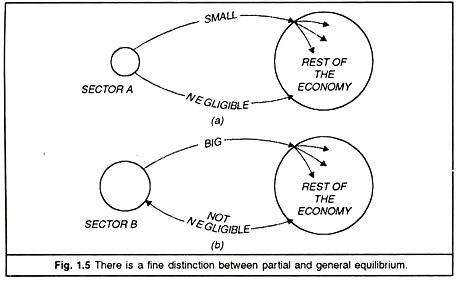This article will help you to learn about the difference between particular equilibrium and general equilibrium.
Difference between Particular Equilibrium and General Equilibrium
It is difficult to draw a hard and fast line between particular and general equilibrium analysis.
“Instead of establishing a dichotomy, it will be preferable to think in terms of moving along a continuum from particular into general equilibrium, or from first-order effect of a disturbance into second; third; and higher order effects.
In fact, modern economic theory takes general equilibrium as just an extension of particular equilibrium. First, we discuss equilibrium of a firm. Next, we extend the analysis to an entire industry and observe the effect of individual firms’ actions upon each other.
ADVERTISEMENTS:
Then, we observe how productive capacity is organised in a competitive economy according to consumer tastes and preferences. Our analysis becomes more and more inclusive as we pass from particular equilibrium to general equilibrium.
Whether a problem is to be taken and solved within the field of particular equilibrium analysis or general equilibrium analysis depends upon the extent of repercussions it has on the rest of the economy and the likely effects received back by the problem sector from the rest of the economy. The distinction between partial and general equilibrium analysis is illustrated in Fig. 1.5.
The upper part of the diagram shows the case of sector A which is so small relative to the economy as a whole that changes in this sector cause such imperceptible changes in the rest of the economy that the feedback on sector A is negligible In this case, partial or particular equilibrium is definitely possible and fruitful. For example, the sector A may be a small toy-producing industry.
ADVERTISEMENTS:
The lower part of the diagram shows the case of sector B where a general equilibrium is necessary. This may be the case of the automobile industry. This industry is so big in relation to the rest of the economy that it has a pronounced effect on other sectors. The rest of the economy undergoes so much change as a result of a change in sector B that the feedback on sector B is not negligible.
